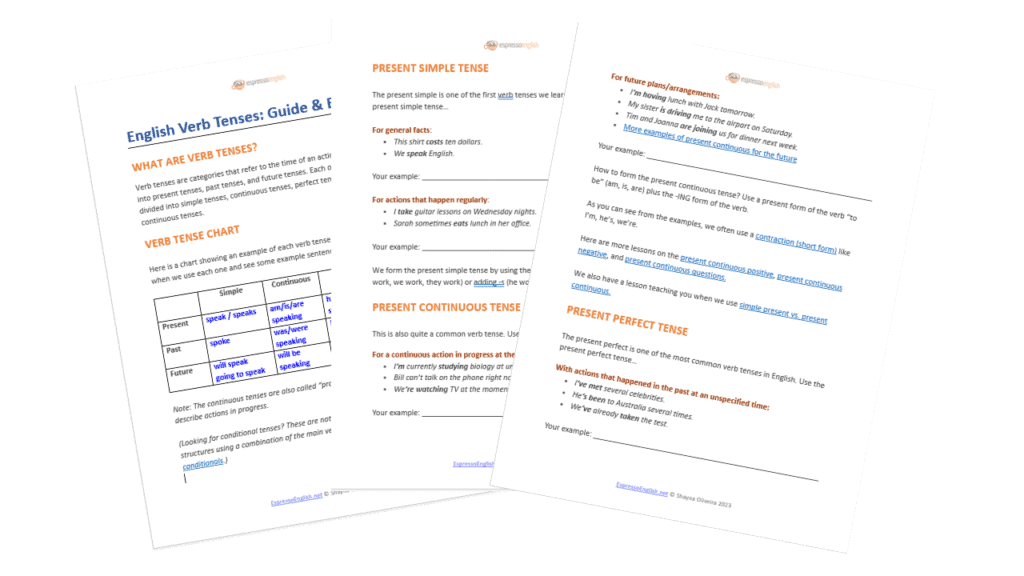

Learn English verb tenses easily! Here’s a quick explanation of each verb tense with example sentences.
Verb tenses are categories that refer to the time of an action. They can be divided into present tenses, past tenses, and future tenses. Each of these can then be divided into simple tenses, continuous tenses, perfect tenses, and perfect continuous tenses.
Here is a chart showing an example of each verb tense – keep reading to find out when we use each one and see some example sentences.
| Simple | Continuous | Perfect | Perfect Continuous | |
| Present | speak / speaks | am/is/are speaking | have/has spoken | have been speaking |
| Past | spoke | was/were speaking | had spoken | had been speaking |
| Future | will speak going to speak | will be speaking | will have spoken | will have been speaking |
Note: The continuous tenses are also called “progressive tenses” since they describe actions in progress.
(Looking for conditional tenses? These are not really tenses, but instead sentence structures using a combination of the main verb tenses. Here’s a good tutorial on conditionals.)

The present simple is one of the first verb tenses we learn in English. Use the present simple tense…
For general facts:
For actions that happen regularly:
We form the present simple tense by using the base form of the verb (I work, you work, we work, they work) or adding -s (he works, she works, it works). Learn more about the simple present tense with “be” and see examples of the present simple positive, present simple negative, and present simple questions.
This is also quite a common verb tense. Use the present continuous in English…
For a continuous action in progress at the moment:
For future plans/arrangements:
How to form the present continuous tense? Use a present form of the verb “to be” (am, is, are) plus the -ING form of the verb. As you can see from the examples, we often use a contraction (short form) like I’m, he’s, we’re.
The present perfect is one of the most common verb tenses in English. Use the present perfect tense…
With actions that happened in the past at an unspecified time:
With actions that began in the past and continue to the present:
Note: Usually the verbs “lived” and “worked.” The present perfect continuous can also be used – see the next section.
With actions that have never happened:
We form the present perfect tense by using “have” or “has” plus the past participle of the verb. “Have/has” is known as the auxiliary verb or helping verb to the main verb.
Check out our complete guide to the present perfect tense for lots more details and examples!
Use the present perfect continuous tense in English…
With actions that began in the past and continue to the present:

Join the Advanced English Grammar Course to learn and practice these tenses in detail – plus many more grammar topics! 45 lessons to help take your English grammar from “good” to GREAT.
Now let’s look at the past tenses – starting with the simple past. Use the simple past tense in English…
For events that started and finished in the past:
We often form the past simple tense by adding -ED to the verb, for regular verbs. Here’s a list of 100+ regular verbs in English.
But what do you notice about the final example of a past tense verb, “went”? It’s irregular! The past tense of “go” is “went” (not “goed”). Many common verbs are irregular in the simple past. Check out these tips for learning irregular verbs in English!
You can find more simple past tense examples in these lessons:
Also, make sure you’re clear on when to use the simple past vs. present perfect.
Use the past continuous tense in English…
For events that were in progress in the past (often when another one-time event happened):
We form the past continuous by using “to be” in the past (was/were) plus the -ING form of the verb. You might also enjoy this lesson on simple past vs. past continuous – examples and more detail about when to use each one.
Use the past perfect tense in English…
For past events that happened BEFORE other past events:
Form the past perfect by using the auxiliary verb “had” and the past participle of the main verb. We often use the short form ‘d, as you can see in the last past perfect example sentence.
In the past perfect, we can even have the structure “had had“!
Use the past perfect continuous tense in English…
For past actions that continued up to another point in the past:
Form the past perfect continuous by using “had been” plus the ING form of the main verb. As in the last example sentence, we often change “had” to the short form ‘d in this verb tense.

Now let’s look at the future tenses!
There are two ways to form the future simple tense in English.
Use the “going to” form of the future simple tense…
For plans, arrangements, and predictions:
Use the “will” form of the future simple tense…
For promises, offers, predictions, and decisions made in the moment of speaking:
The future simple is a very common verb tense; native English speakers use it often.
A lot of English learners aren’t sure when to use going to vs. will – and we have a lesson on that!
Use the future continuous tense in English…
For actions that will be in progress at a time in the future:
To form the future continuous, use “will be” + the ING form of the main verb.
Use the future perfect tense in English…
For actions that will be completed before a future time:
To form the future perfect, use “will have” + the past participle of the main verb.
As you can see in the example sentences, we often use “before,” “by,” or “by the time” with the future perfect tense.
Use the future perfect continuous tense in English…
For actions that will continue up to a future time:
Note: BY and BY THE TIME are commonly used with the future perfect continuous.
The future continuous is one of the least common verb tenses in English.
Learn about more advanced sentence structures:
Many English learners have difficulty with verb tenses – they often stop to think “which verb tense should I use?” and the rules about tenses can be confusing. I hope this lesson has helped you understand the differences between verb tenses in English.
…but don’t just read about verb tenses, you also need to practice them! I recommend writing your own example sentence with every verb tense in this lesson. The more example sentences you write, the easier it will be to remember the structure of the verb tenses and when we use each one.
You can learn about verb tenses in much more detail inside my Advanced English Grammar Course. The lessons include quizzes to help you review and practice the verb tenses, and there’s also the option to do “writing tasks” and send them in for feedback and grammar correction from our teaching team.
This is very valuable because you can find out if you’re making any mistakes with the English tenses… or using them correctly!